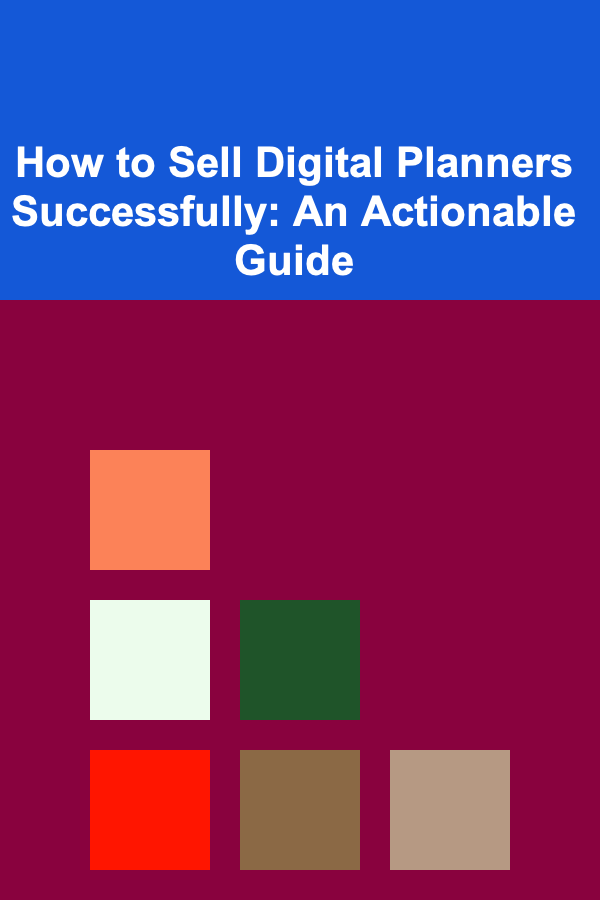
How to Sell Digital Planners Successfully: An Actionable Guide
ebook include PDF & Audio bundle (Micro Guide)
$12.99$5.99
Limited Time Offer! Order within the next:

Selling digital planners has become an increasingly popular way for entrepreneurs to tap into the growing market of productivity tools, particularly as people seek more organized and efficient ways to manage their time. Digital planners offer a unique solution to the traditional paper planner, combining the benefits of modern technology with the need for organization, and they are highly favored by those who are always on the go. Whether you're a designer, a productivity enthusiast, or a digital product seller, there's ample potential to create a thriving business by selling digital planners.
However, the success of selling digital planners requires more than just creating a beautiful product. It involves understanding your target market, mastering the nuances of digital product creation, marketing effectively, and ensuring the best customer experience. This guide will walk you through the essential steps to sell digital planners successfully.
Understand Your Niche
Before you dive into designing and selling digital planners, it's important to have a clear understanding of the niche you want to target. Digital planners cater to a wide range of people, so narrowing down your focus will help you create a product that resonates with a specific audience.
Research Your Target Audience
Digital planners appeal to various demographics, from students and professionals to stay-at-home parents and fitness enthusiasts. Think about who your ideal customer is and what their needs are. You might want to consider:
- Professionals and Entrepreneurs: Digital planners that help with time management, task delegation, project planning, and goal setting.
- Students: Planners tailored to academic schedules, homework tracking, and exam preparation.
- Health & Wellness Enthusiasts: Digital planners focused on fitness tracking, meal planning, and mindfulness.
- Parents and Caregivers: Family-centric planners for meal planning, child activities, and home organization.
Identify Gaps in the Market
Examine what types of digital planners are already available on platforms like Etsy or Gumroad. Look for opportunities to create something unique that addresses an underserved need in the market. For example, are there enough planners that cater to eco-conscious users, or planners designed for a specific group (e.g., remote workers, mental health trackers)?
Actionable Tip: Create a customer persona to better understand the specific needs and pain points of your target audience. This will help you design a product that they will find valuable and be willing to buy.
Design Your Digital Planner
The design of your digital planner is crucial for both its usability and appeal. Your planner should not only be aesthetically pleasing but also functional, intuitive, and easy to navigate.
Choose the Right Software
To create a high-quality digital planner, you'll need the right design software. Some popular tools include:
- Adobe InDesign: Best for creating professional-level layouts and highly customizable designs.
- Canva: A user-friendly platform with templates for creating attractive planners, perfect for beginners.
- GoodNotes or Notability Templates: If you're creating planners for specific apps like GoodNotes or Notability, ensure the design is compatible with these platforms.
Layout and Features
A digital planner should be easy to use and well-organized. Common sections include:
- Monthly, Weekly, and Daily Views: Include layouts for different timeframes to cater to various planning styles.
- Task and Goal Tracking: Provide sections for tasks, to-dos, goals, and progress tracking.
- Customization Options: Offer different themes or color schemes, font styles, and layouts to cater to personal preferences.
- Interactive Features: Add clickable links for navigation (e.g., links from the monthly view to specific weeks).
Consider Usability
Remember that your planner should be designed for digital use, so ensure that it's optimized for tablets, iPads, and phones. It should be easy for users to add, delete, or move around sections. Test your planner on different devices to ensure compatibility and ease of use.
Actionable Tip: Design your digital planner with minimalism in mind. Too much complexity can overwhelm users. Focus on making the planner functional and simple, with easy navigation.
Choose the Right Platform for Selling
Once your digital planner is ready, it's time to choose a platform to sell it. The platform you select will determine how you market, price, and distribute your product.
Etsy
Etsy is a popular platform for selling digital products, including planners. It has a built-in audience of people who are already looking for unique, handmade, and digital goods. The downside is that Etsy charges fees (listing, transaction, and payment processing fees), and competition can be stiff.
- Pros: Wide audience, easy-to-use interface, and the ability to offer instant downloads.
- Cons: High competition and fees, which can eat into your profits.
Gumroad
Gumroad is another great platform for selling digital planners. It's easy to use, and the platform allows you to sell directly to your audience without the need for a storefront. You can also set your pricing and offer discounts or bundles.
- Pros: Low fees and simple setup, great for selling directly to your followers.
- Cons: Smaller marketplace compared to Etsy, so marketing efforts will be essential.
Shopify
For a more professional, customizable approach, you can set up your own website using Shopify. This gives you full control over your branding and customer experience.
- Pros: Full control over your store, customization options, and customer data.
- Cons: Monthly fees and more setup work.
Actionable Tip: If you're just starting out, consider using platforms like Etsy or Gumroad to test your products. As your business grows, you can expand to your own website or use multiple platforms.
Price Your Digital Planner
Pricing your digital planner is a delicate balance between perceived value, production costs (even though it's a digital product, you may have software or design fees), and what your target market is willing to pay.
Consider Your Costs
While digital products have low production costs, you should still account for your design time, marketing, and platform fees when pricing your planner.
- Base Price: Research your competitors and set a base price that reflects the quality of your product. Digital planners typically range from $5 to $50 depending on their complexity, features, and customization options.
- Discounts and Bundles: Offering bundle deals (e.g., buying a 3-month planner for a discount) or occasional sales can help drive more traffic to your shop.
Actionable Tip: Consider offering tiered pricing with different levels of customization or bonus features (such as bonus sections, additional templates, etc.) for customers who want more value.
Market Your Digital Planner
Creating a high-quality digital planner is just the first step; getting people to buy it is where the real work begins.
Utilize Social Media
Platforms like Instagram, Pinterest, and TikTok are ideal for showcasing your digital planners. You can share content that demonstrates the value of your planner, including:
- Behind-the-scenes content showing how you create your planners.
- Tutorials or walkthroughs showing how to use your planner on a tablet or phone.
- User-generated content where customers share how they use your planner.
Content Marketing and Blogging
Consider starting a blog or YouTube channel that focuses on productivity, organization, or digital tools. Write content that educates your audience about the benefits of using a digital planner and how it can improve their lives. You can then link to your digital planner as a solution.
Collaborate with Influencers
Partnering with influencers in the productivity, wellness, or lifestyle space can help you reach a larger audience. Look for micro-influencers who have a niche following and are passionate about productivity tools.
Actionable Tip: Use Instagram Stories and Pinterest Pins to showcase your planner in action. Share practical tips on how to get the most out of your digital planner.
Provide Excellent Customer Service
Customer satisfaction is critical when selling digital products. While digital planners don't require physical shipping, you should still focus on providing excellent service to your customers.
Quick Response Times
If customers have questions or issues with your digital planner (e.g., downloading the file), respond quickly. Excellent customer service will lead to positive reviews and repeat business.
Offer Refunds or Exchanges
While digital products are often non-refundable, you can offer refunds or exchanges if there's an issue with the file or product. Providing clear terms and conditions will help avoid misunderstandings.
Actionable Tip: Set up an FAQ page on your website or product listing that answers common questions about downloading and using the planner. This can reduce the number of inquiries you receive and improve the customer experience.
Continuously Improve and Update Your Planners
Digital planners are not set-it-and-forget-it products. Continuously improving and updating your planners will help you stay relevant and keep your audience engaged.
Customer Feedback
Encourage customers to provide feedback on your digital planners. Use this feedback to improve your designs, add new features, and create new planner versions.
Seasonal Updates
Consider offering seasonal or yearly updates to keep your product fresh. For example, you can add new layouts or features based on customer demand or trends in the planner community.
Actionable Tip: Stay up-to-date with trends in productivity tools. As new technologies or apps emerge, ensure your planner remains compatible and offers cutting-edge features.
Conclusion
Selling digital planners successfully requires a combination of creativity, strategic planning, and continuous effort. By understanding your target audience, designing a user-friendly product, choosing the right platform, and executing effective marketing strategies, you can create a profitable business. Remember to offer exceptional customer service, keep your products updated, and always look for ways to improve your offerings to stay competitive in this growing market. With these actionable steps, you'll be well on your way to building a successful digital planner business.

How to Add Luxury Features to Your Home Renovation on a Budget
Read More
How to Build Financial Confidence and Take Control of Your Money
Read More
How to Make a Job Interview Checklist for Presenting Your Portfolio or Work Samples: An Actionable Guide
Read More
How to Store Your Wine Collection Without Taking Up Space
Read More
How to Use Deep Learning to Build Profitable SaaS Products
Read More
Maximize Efficiency with These 7 Expert Energy-Saving Tips
Read MoreOther Products

How to Add Luxury Features to Your Home Renovation on a Budget
Read More
How to Build Financial Confidence and Take Control of Your Money
Read More
How to Make a Job Interview Checklist for Presenting Your Portfolio or Work Samples: An Actionable Guide
Read More
How to Store Your Wine Collection Without Taking Up Space
Read More
How to Use Deep Learning to Build Profitable SaaS Products
Read More